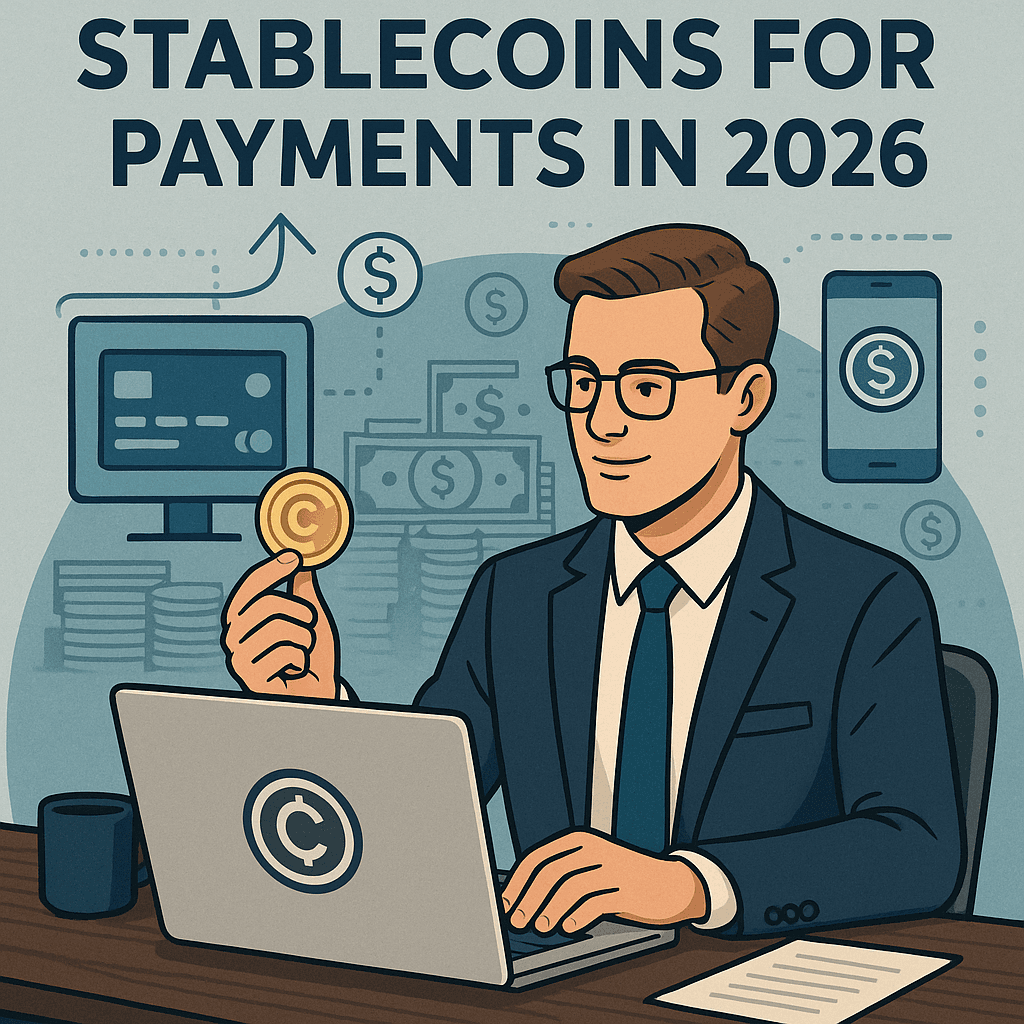The future of programmable money isn't found in complex smart contracts, it's in smart accounts that generate instant yield from the moment funds arrive. While the crypto industry has spent years building sophisticated smart contracts, a quiet revolution is transforming how businesses think about DeFi treasury management and yield-generating smart accounts.
Programmable money represents digital currency that can be automatically managed through software programs, but the breakthrough isn't just making contracts smarter, it's making money itself programmable at the account level. This shift is creating new opportunities for crypto business banking and automated yield optimization that go far beyond traditional DeFi protocols.
What is Programmable Money? Smart Contracts vs. Smart Accounts
Understanding Smart Contracts: The Foundation
Smart contracts are self-executing agreements with terms directly written into code. These programmable yield systems have powered everything from DeFi lending to automated payments, enabling transactions to execute when predetermined conditions are met.
Smart contracts function like sophisticated vending machines: insert the correct payment, meet the conditions, and receive the programmed result. However, the money flowing through these contracts remains fundamentally "dumb", it only becomes programmable when interacting with the contract itself.
The Smart Account Revolution: Account-Level Programmability
Smart accounts represent the next evolution in programmable money infrastructure. Instead of adding programmable logic to individual transactions, the account itself becomes programmable through standards like ERC-4337 account abstraction.
ERC-4337 "allows users to use smart contract wallets containing arbitrary verification logic instead of EOAs as their primary account." This means every deposit, transfer, and payment can automatically execute complex financial workflows without manual intervention.
Why Instant Yield Matters for Business DeFi
Traditional Payment Processing vs. Programmable Accounts
Consider how businesses currently handle payments:
Traditional Process:
Receive payment → funds sit idle
Manual transfer to treasury account
Research yield opportunities
Execute yield strategy (separate transaction)
Monitor and rebalance manually
Smart Account Process:
Receive payment → instant yield deployment in same transaction
Automatic optimization across DeFi yield strategies
Continuous monitoring and rebalancing
Real-time treasury reporting
This represents a fundamental shift from payments as a cost center to payments as a revenue generator through instant yield infrastructure.
The $247 Billion Stablecoin Opportunity
Stablecoin adoption is rapidly expanding with over 161 million holders globally - more than the population of the 10 largest cities combined. Global stablecoin supply grew 54% year-over-year, reaching $247 billion as businesses discover the benefits of USD-denominated programmable accounts.
One-third of small and medium businesses now use crypto (doubling from 2024), indicating massive adoption of crypto cash management solutions. This creates enormous demand for high-yield business bank accounts that can automatically optimize capital efficiency.
Technical Architecture: How Smart Accounts Enable Instant Yield
ERC-4337: Ethereum's Smart Account Standard
Account abstraction through ERC-4337 enables several breakthrough features for programmable yield optimization:
UserOperations: Bundle multiple actions into single transactions
Paymasters: Enable gasless transactions and fee sponsorship
Custom signatures: Support biometric and social login methods
Recovery mechanisms: Automated account recovery without seed phrases
ERC-4337 enhances intelligent fee management, allowing users to pay transaction fees in ERC-20 tokens while enabling yield-earning escrows and automated treasury management.
Solana's Native Programmable Architecture
While Ethereum required ERC-4337 to retrofit smart account functionality, Solana was designed with programmable accounts from inception. The Solana Virtual Machine (SVM) structures wallets as independent, customizable accounts with dedicated data space.
This native programmability enables more sophisticated DeFi treasury tools:
Parallel processing: Lightning-fast transaction execution across multiple accounts
Cost efficiency: Consistently low fees even during high-volume activity
Flexible management: Create and manage multiple specialized accounts
Smart account architecture: Built-in support for complex financial logic
Real-World Applications of Programmable Money
Instant Yield Infrastructure for Business Banking
The most transformative application is instant yield on business funds, every deposit becomes productive in the same transaction it's received. This goes beyond traditional stablecoin yield to create entirely new financial workflows.
Pull-based payments represent another innovation: instead of pushing funds to recipients, smart accounts can authorize payouts that recipients claim when ready. The sender continues earning yield on idle capital until the exact moment of collection, maximizing capital efficiency.
Crypto Point of Sale with Automatic Yield
Accept crypto payments in store while automatically deploying funds to yield-generating protocols. A crypto point of sale system built on smart accounts can:
Accept any token type (USDC payment processing, meme coins, etc.)
Instantly swap to preferred stablecoins
Deploy to non-custodial yield accounts
Generate passive income from DeFi stablecoins
This transforms merchant payments from a transaction cost into a yield-bearing business asset.
Programmable Subscriptions and Automated Billing
Smart accounts enable crypto subscriptions where prepaid balances earn yield until consumed. Instead of traditional recurring payments sitting idle between billing cycles, yield-bearing crypto payment tools can:
Generate returns that offset subscription costs
Enable pay gas with stablecoins functionality
Automate cross-border crypto payments
Implement smart wallet with yield features
DeFi Infrastructure for Institutions and Builders
White-Label Programmable Money APIs
Financial institutions exploring DeFi infrastructure for banks can leverage smart account technology without building from scratch. White-label stablecoin infrastructure enables banks to offer:
Yield engine for fintech applications
Programmable money APIs for developers
Stablecoin banking rails with instant settlement
Crypto developer banking tools for custom applications
The Regulatory Advantage
As stablecoin regulations clarify globally, institutions need programmable money infrastructure that remains compliant while offering competitive yields. Smart accounts separate the compliance layer (custody, KYC/AML) from the programmable layer (yield optimization, automation).
User Experience: Making DeFi Invisible
From Complex to Automatic
The most profound impact of programmable yield isn't technical, it's experiential. Users don't need to understand DeFi yield routing or stablecoin yield infrastructure. Their account simply does more with their money automatically.
Account abstraction signifies the concealment of technical details involved in Web3 interactions, creating bank-like experiences with crypto savings accounts that earn yield.
Enhanced Security Through Programmability
Smart accounts implement advanced security features impossible with traditional accounts:
Multi-signature requirements for large transactions
Social recovery through verified contacts
Spending limits and cooling-off periods
Time-based controls for different account functions
Market Implications: The Stablecoin Infrastructure Race
Business Adoption Accelerating
More than 4 in 5 institutional investors plan to increase crypto exposure, while 6 in 10 F500 executives report active blockchain initiatives. This institutional momentum creates massive demand for crypto treasury management solutions.
82% of SMBs believe crypto can help address financial pain points, particularly around cross-border payments and transaction processing fees. Smart accounts address these needs while generating additional revenue through automated yield optimization.
The Network Effect Opportunity
Platforms building programmable money infrastructure today position themselves to capture value from every future innovation in DeFi business banking. As more capital flows through smart account systems, yield optimization algorithms become more sophisticated and profitable.
The platforms establishing early network effects whether through USDC yield accounts for businesses or consumer DeFi banking applications create sustainable competitive advantages.
Implementation Strategies for Businesses
Getting Started with Programmable Accounts
Businesses exploring earn yield on business funds strategies should consider:
Stablecoin treasury conversion: Move idle cash to USDC savings accounts with instant yield
Payment system upgrade: Implement crypto invoice processing with automatic yield deployment
Payroll optimization: Use pull-based crypto payments to maintain yield until disbursement
Subscription monetization: Convert customer prepayments to yield-bearing balances
Competitive Advantages of Early Adoption
Businesses implementing programmable money infrastructure gain several advantages:
Revenue from payments: Transform transaction costs into profit centers
Capital efficiency: Maximize returns on all business funds
Automated operations: Reduce manual treasury management overhead
Customer benefits: Offer yield-sharing and loyalty programs
The Future is Programmable by Design
We're witnessing the emergence of programmable money as the new financial operating system. Smart accounts aren't just an improvement on existing wallets—they're the foundation for financial innovation we can't yet imagine.
The question isn't whether programmable yield will become standard. With 245x growth in real-world asset tokenization and 54% growth in stablecoin supply, the infrastructure is maturing rapidly.
The question is which platforms will build the most compelling instant yield DeFi implementations fast enough to establish network effects before the technology becomes commoditized.
Programmable money through smart accounts represents more than technological advancement, it's the foundation for a financial system where every dollar works harder, every transaction creates value, and every user benefits from automation previously available only to institutions.
The future of money isn't just programmable. It's profitable by design.
Frequently Asked Questions
Q: How does programmable money differ from traditional DeFi?
A: Programmable money makes the account itself programmable, not just individual transactions. This enables instant yield and automated financial workflows without manual intervention.
Q: What's the difference between smart contracts and smart accounts?
A: Smart contracts add programmability to transactions, while smart accounts make the account itself programmable. This enables more sophisticated automation and yield optimization.
Q: How can businesses start earning yield on payments?
A: Businesses can implement smart account infrastructure that automatically deploys incoming payments to yield-generating protocols while maintaining full liquidity and control.
Q: Is programmable money safe for business use?
A: Smart accounts actually enhance security through features like multi-signature requirements, social recovery, and programmable spending controls while maintaining non-custodial ownership.
Ready to transform your business payments into a revenue generator? Learn how RebelFi's smart account infrastructure enables instant yield on every transaction with industry-leading DeFi business banking solutions.



